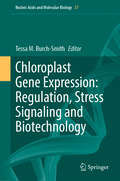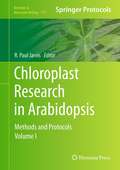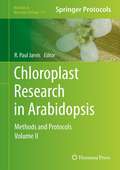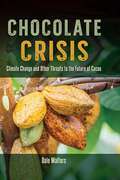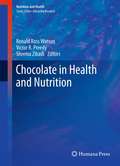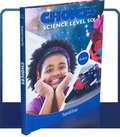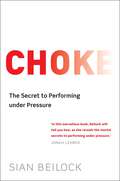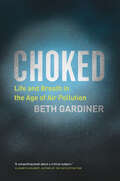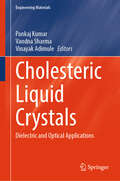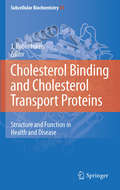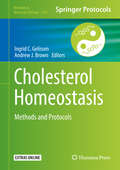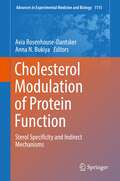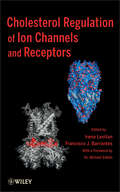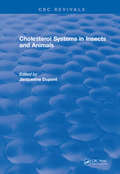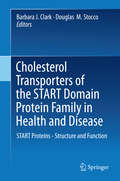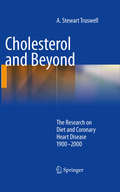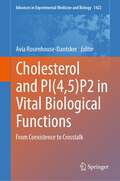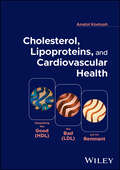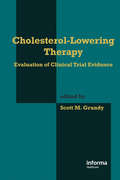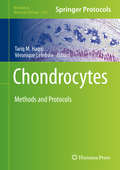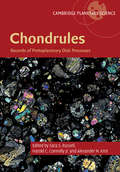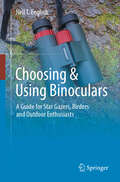- Table View
- List View
Chloroplast Gene Expression: Regulation, Stress Signaling and Biotechnology (Nucleic Acids and Molecular Biology #37)
by Tessa M. Burch-SmithThis book provides an insightful journey into the realm of chloroplast biology. Chloroplasts are the organelles that perform photosynthesis and many of the metabolic processes in plant cells. They are a specialized form of plastids, whose differentiation is dependent on environmental and developmental signaling. Descended from a lineage of free-living, photosynthesizing prokaryotes, chloroplasts and other plastids contain remnants of their ancient genomes and chloroplast gene expression is essential for establishing functional organelles. Chloroplast gene expression has features of the prokaryotic gene expression but now involves large suites of nuclear proteins. Topics discussed are: the identification of these nuclear factors how chloroplast RNA is processed to produce functional organelles translation in chloroplasts and its regulation the environmental factors that influence chloroplast development and how plants deal with defective chloroplasts. The book also highlights the evolving landscape of chloroplast engineering in biotechnology, recent breakthroughs and their implications for the future. A valuable resource for researchers, students, and enthusiasts alike, this book is a compelling testament to the fascinating world of chloroplasts and their burgeoning role in scientific innovation.
Chloroplast Research in Arabidopsis: Methods and Protocols, Volume I (Methods in Molecular Biology #774)
by R. Paul JarvisChloroplasts are essential for the survival and flourishing of life on Earth. Over the years, chloroplast biology has been studied in a variety of different organisms, leading to the significant disadvantage that findings which were made by using different experimental systems or species were not always directly cross-comparable. The relatively recent adoption of Arabidopsis thaliana as the model organism of choice for plant science research, across the globe, has led to its emergence as a pre-eminent system for research on chloroplasts and other types of plastid. In Chloroplast Research in Arabidopsis: Methods and Protocols, expert researchers bring together some of the most important, modern techniques and approaches for chloroplast research, with the unifying theme of Arabidopsis as the model system. Volume I explores topics such as genetics, cytology, in vivo analysis, gene expression, and protein accumulation, as well as protein transport, localization, and topology. Written in the highly successful Methods in Molecular BiologyTM series format, chapters include introductions to their respective topics, lists of the necessary materials and reagents, step-by-step, readily reproducible laboratory protocols, and tips on troubleshooting and avoiding known pitfalls. Authoritative and convenient, Chloroplast Research in Arabidopsis: Methods and Protocols serves as an ideal reference for all researchers with a general interest in chloroplasts, plastids, or related processes.
Chloroplast Research in Arabidopsis: Methods and Protocols, Volume II (Methods in Molecular Biology #775)
by R. Paul JarvisChloroplasts are essential for the survival and flourishing of life on Earth. Over the years, chloroplast biology has been studied in a variety of different organisms, leading to the significant disadvantage that findings which were made by using different experimental systems or species were not always directly cross-comparable. The relatively recent adoption of Arabidopsis thaliana as the model organism of choice for plant science research, across the globe, has led to its emergence as a pre-eminent system for research on chloroplasts and other types of plastid. In Chloroplast Research in Arabidopsis: Methods and Protocols, expert researchers bring together some of the most important, modern techniques and approaches for chloroplast research, with the unifying theme of Arabidopsis as the model system. Volume II explores topics such as multiprotein complexes, protein-protein interactions, omics and large-scale analyses, proteomics and suborganellar fractionation, as well as photosynthesis and biochemical analysis. Written in the highly successful Methods in Molecular BiologyTM series format, chapters include introductions to their respective topics, lists of the necessary materials and reagents, step-by-step, readily reproducible laboratory protocols, and tips on troubleshooting and avoiding known pitfalls. Authoritative and convenient, Chloroplast Research in Arabidopsis: Methods and Protocols serves as an ideal reference for all researchers with a general interest in chloroplasts, plastids, or related processes.
Chocolate Crisis: Climate Change and Other Threats to the Future of Cacao
by Dale WaltersChocolate is the center of a massive global industry worth billions of dollars annually, yet its future in our modern world is currently under threat. In Chocolate Crisis, Dale Walters discusses the problems posed by plant diseases, pests, and climate change, looking at what these mean for the survival of the cacao tree.Walters takes readers to the origins of the cacao tree in the Amazon basin of South America, describing how ancient cultures used the beans produced by the plant, and follows the rise of chocolate as an international commodity over many centuries. He explains that most cacao is now grown on small family farms in Latin America, West Africa, and Indonesia, and that the crop is not easy to make a living from. Diseases such as frosty pod rot, witches’ broom, and swollen shoot, along with pests such as sap-sucking capsids, cocoa pod borers, and termites, cause substantial losses every year. Most alarmingly, cacao growers are beginning to experience the accelerating effects of global warming and deforestation. Projections suggest that cultivation in many of the world’s traditional cacao-growing regions might soon become impossible.Providing an up-to-date picture of the state of the cacao bean today, this book also includes a look at complex issues such as farmer poverty and child labor, and examines options for sustainable production amid a changing climate. Walters shows that the industry must tackle these problems in order to save this global cultural staple and to protect the people who make their livelihoods from producing it.
Chocolate in Health and Nutrition (Nutrition and Health)
by Victor R. Preedy Ronald Ross Watson Sherma ZibadiChocolate in Health and Nutrition represents the first comprehensive compilation of the newest data on the actions of the flavonoids and microorganisms associated with the beneficial effects of chocolate. This unique text provides practical, data-driven resources based upon the totality of the evidence to help the reader understand the basics, treatments and preventive strategies that are involved in the understanding of the role chocolate may play in healthy individuals as well as those with cardiovascular disease, diabetes or neurocognitive declines. Of equal importance, critical issues that involve patient concerns, such as dental caries and food preferences in children, potential effects on weight gain, addiction and withdrawal are included in well-referenced, informative chapters. The latest research on the role of chocolate in normal health areas including mood, pain and weight management, cardiovascular disease and related conditions are presented. Chocolate in Health and Nutrition provides health professionals in many areas of research and practice with the most up-to-date, well referenced and comprehensive volume on the current state of the science and medical uses of chocolate.
Chocolate: Sweet Science & Dark Secrets of the World's Favorite Treat
by Kay FrydenborgChocolate hits all the right sweet--and bitter--notes: cutting-edge genetic science whisked in with a strong social conscience, history, and culture yield one thought-provoking look into one of the world's most popular foods. Readers who savored Chew on This and Food, Inc. and lovers of chocolate will relish this fascinating read.
Choices: Science Level Six
by AcsiYour sixth graders will acquire valuable skills through age-appropriate scientific inquiry while gaining a deeper appreciation of God's creation. This colorful hardcover text provides an engaging, hands-on, full-time instructional program. This science series was developed to guide students through investigating, observing and thinking about the world around them. Every chapter is designed to bring together the wonders of God's world and a Biblical worldview. The title of the series comes from the idea that God's design of creation was on purpose, and that theme is reflected throughout the lessons.
Choke: The Secret To Performing Under Pressure
by Sian BeilockIn the tradition of Steven Pinker's How the Mind Works, popular psychologist Sian Beilock, an expert on performance and brain science, reveals the astonishing new science of why we choke under pressure. She explains what happens in the body and mind when everything clicks and the perfect golf swing, tricky mathematical problem, or high-pressure business pitch suddenly become easy.With surprising insights on every page, Beilock examines how: attention and working memory guide human performance; how experience and practice, innate factors, and brain development interact to create our abilities;how these interconnected elements react to stress - explaining counterintuitive realities, like why the cleverest students do worst on standardized tests; why we may learn foreign languages best when we're not paying attention; why early childhood athletic training can backfire; and how our emotions can make us both smarter and dumber.the mind and body are in even closer communication than was ever thought - and breaks new ground on top of 30 years of integrative health investigations.
Choked: Life and Breath in the Age of Air Pollution
by Beth Gardiner“[An] arresting account of one of the biggest environmental threats to human health.” —Scientific AmericanAir pollution prematurely kills seven million people every year, including more than one hundred thousand Americans. It is strongly linked to strokes, heart attacks, many kinds of cancer, dementia, and premature birth, among other ailments. In Choked, Beth Gardiner travels the world to tell the story of this modern-day plague, taking readers from the halls of power in Washington and the diesel-fogged London streets to Poland’s coal heartland and India’s gasping capital. In a gripping narrative, she exposes the political decisions and economic forces that have kept so many of us breathing dirty air. This is a moving, up-close look at the human toll, where we meet the scientists who have transformed our understanding of pollution’s effects on the body and the ordinary people fighting for a cleaner future.“A compelling book about a critical subject.” —Elizabeth Kolbert, Pulitzer Prize–winning author of The Sixth Extinction“Illuminates some disturbing realities, but it also gives us hope by showing us what we can do to clean our air. . . . An urgent, essential read.” —Arnold Schwarzenegger“Moving . . . By putting a human face on a problem of environmental chemistry, Gardiner shows us the devastation up close, creating a sense of dismay but also urgency to improve lives.” —Washington Post“Timely, eloquent, and disturbing.” —Nature“You couldn’t ask for a better guide for nonspecialists and concerned citizens.” —Guardian, Best Book of the Year“Remarkable.” —Science“Brilliantly reported and beautifully written.” —Anna Clark, author of The Poisoned City
Cholesteric Liquid Crystals: Dielectric and Optical Applications (Engineering Materials)
by Pankaj Kumar Vinayak Adimule Vandna SharmaThis book highlights the latest developments and advancements in cholesteric liquid crystals. It covers a wide range of techniques to develop/modify the cholesteric liquid crystal systems with various optically active chiral dopants. It presents the unexplored features of cholesteric liquid crystals, their diverse properties such as fluorescence, photoluminescence, utility in optical smart windows, optical switching states, energy, and sensor usage with the modification by various carbon-based nanomaterials as intercalating substances. The book examines developments in the field of size and shape of cholesteric liquid crystals. In summary, the book is essential for readers to understand all parameters of cholesteric liquid crystals relating to the device architectures, techniques of formation, optical storage applications, display properties, and various diversified applications in the field of optical smart windows, molecular switches, etc.
Cholesterol Binding and Cholesterol Transport Proteins: Structure and Function in Health and Disease (Subcellular Biochemistry #51)
by J. Robin HarrisKnowledge of cholesterol and its interaction with protein molecules is of fundamental importance in both animal and human biology. This book contains 22 chapters, dealing in depth with structural and functional aspects of the currently known and extremely diverse unrelated families of cholesterol-binding and cholesterol transport proteins. By drawing together this range of topics the Editor has attempted to correlate this broad field of study for the first time. Technical aspects are given considerable emphasis, particularly in relation cholesterol reporter molecules and to the isolation and study of membrane cholesterol- and sphingomyelin-rich "raft" domains. Cell biological, biochemical and clinical topics are included in this book, which serve to emphasize the acknowledged and important benefits to be gained from the study of cholesterol and cholesterol-binding proteins within the biomedical sciences and the involvement of cholesterol in several clinical disorders. It is hoped that by presenting this topic in this integrated manner that an appreciation of the fact that there is much more that needs to be taken into account, studied and understood than the widely discussed "bad and good cholesterol" associated, respectively, with the low- and high-density lipoproteins, LDL and HDL.
Cholesterol Homeostasis
by Ingrid C. Gelissen Andrew J. BrownThis volume provides state-of-the-art techniques for studying various aspects of cholesterol homeostasis, including its uptake, synthesis and efflux from the cell, as well as its trafficking within the cell. Chapters also cover techniques for studying the regulation of cholesterol homeostasis at both the transcriptional and post-translational levels, as well as studying the membrane topology and structure of cholesterol-related proteins. Written in the highly successful Methods in Molecular Biology series format, chapters include introductions to their respective topics, lists of the necessary materials and reagents, step-by-step, readily reproducible laboratory protocols, and tips on troubleshooting and avoiding known pitfalls.Authoritative and practical, Cholesterol Homeostasis: Methods and Protocols aims to provide key techniques in tackling the investigation of cholesterol homeostasis.
Cholesterol Modulation of Protein Function: Sterol Specificity and Indirect Mechanisms (Advances in Experimental Medicine and Biology #1115)
by Avia Rosenhouse-Dantsker Anna N. BukiyaIn this book, renowned scientists describe the role of steroid chirality and modification of lipid membrane physical properties in the modulation of G protein-coupled receptors and ion channels. The application of commonly-used technical approaches such as mass spectrometry and nucleic magnetic resonance transfer spectroscopy for studies on cholesterol distribution and alteration of lipid bilayer characteristics is also discussed. This book offers comprehensive insights into the current understanding of cholesterol-driven modulation of protein function via mechanisms that extend beyond lipid-protein direct interactions. In the first part, the chapters introduce the reader to the use of the chemical derivatives of cholesterol as a valuable laboratory tool in the studies of cholesterol-driven modulation of protein function. In the second part, examples of cholesterol-induced changes in membrane physical characteristics are presented and discussed in light of their multifaceted contribution to the effect of cholesterol on protein function. The book will be of interest to undergraduate and graduate students as well as basic science and medical researchers with a keen interest in the biophysical properties of cholesterol and physiological consequences of cholesterol presence in biological systems.
Cholesterol Regulation of Ion Channels and Receptors
by Francisco Barrantes Irena LevitanExamines new research on the role of cholesterol in regulating ion channels and receptors and its effect on healthDrawing together and analyzing all the latest research findings, this book explores the role of cholesterol in the regulation of ion channels and receptors, including its pathological effects. It is the first book to comprehensively describe the complex mechanisms by which cholesterol regulates two major classes of membrane proteins. Moreover, it sheds new light on how cholesterol affects essential cellular functions such as the contraction of the heart, propagation of nerve impulses, and regulation of blood pressure and kidney function.Written and edited by leading pioneers in the field, Cholesterol Regulation of Ion Channels and Receptors is divided into three parts:Part I, Cholesterol Regulation of Membrane Properties, introduces the heterogeneity of cholesterol distribution in biological membranes and the physical and biological implications of the formation of cholesterol-rich membrane domains.Part II, Cholesterol Regulation of Ion Channels, examines the mechanisms underlying cholesterol sensitivities of ion channels, including the regulation of ion channels by cholesterol as a boundary lipid.Part III, Cholesterol Regulation of Receptors, explores the latest discoveries concerning how cholesterol regulates distinct types of receptors, including G-protein coupled receptors, LDL and scavenger receptors, and innate immune system receptors.Increased levels of cholesterol represent a major health risk. Understanding cholesterol regulation of ion channels and receptors is essential for facilitating the development of new therapeutic strategies to alleviate the impact of pathological cholesterol conditions. With this book as their guide, readers have access to the most current knowledge in the field.
Cholesterol Systems in Insects and Animals
by Jacqueline DupontThe reviews in this collection are unique in their intent to provide a basis for understanding of the subject. They include historical, descriptive, and comparative information which is not always presented in �state of the science� reviews. Cholesterol is viewed in each chapter as part of a system � structural, kinetic, or metabolic. The complex nature of the place of cholesterol in living systems is illustrated in each chapter.
Cholesterol Transporters of the START Domain Protein Family in Health and Disease: START Proteins - Structure and Function
by Barbara J. Clark Douglas M. StoccoNon-vesicular intracellular cholesterol transport is an important mechanism for maintaining membrane cholesterol homeostasis. Recent reports of studies directed at soluble cholesterol transport proteins indicate that aberrant expression of the START proteins may contribute to disease states associated with disorders in cholesterol homeostasis. This is an exciting new direction in the field and the purpose of this book will be to highlight the current research directed at potential roles for the START family in diabetes, cancer and atherogenesis. This book also provides a personal and historical perspective of the discovery-to-publication journey that the authors had for their particular START domain family member. The goal will be to provide perspectives to graduate students, post-doctoral fellows and endocrinology fellows on the research discovery process.
Cholesterol and Beyond: The Research on Diet and Coronary Heart Disease 1900-2000
by A. Stewart Truswell"Only once in a great while does a book come along that really does the job in addressing a major medical issue. When this happens, all can be joyful... Readers will find ALL their favorite dietary puzzlements dealt with... With consummate scholarship, clarity and brevity, Truswell sifts out the chaff and identifies the critical questions, the responsible investigators, and the key studies." So says Emeritus Professor Henry Blackburn from the University of Minnesota in the foreword to this remarkable concise book on the history of research on diet and heart disease. This was a theme of scientific, medical and public interest in the 20th Century, a century marked by the rise and fall of coronary heart disease as the major cause of death in the first world, followed by the rise of this cause of death in the developing world. There is obviously much to learn, and this book is an excellent starting point, tracing dietary factors and their role in heart disease one by one: fats, sugar, salt, alcohol, coffee, trans-fats, etc. Without an understanding of the role of diet and the changes that have been seen in the North American and NW European diet, the story of the decline in the heart disease death rate may have been very different.
Cholesterol and PI: From Coexistence to Crosstalk (Advances in Experimental Medicine and Biology #1422)
by Avia Rosenhouse-DantskerCholesterol is an essential component of the plasma membrane. Phosphatidylinositol 4,5-bisphosphate (PI(4,5)P2), although a minor phospholipid, is the most abundant membrane phosphoinositide. Both lipids play key roles in a variety of cellular functions including as signalling molecules and major regulators of protein function. Studies on these important lipids have traditionally focused on the effect of each lipid individually. Accumulating evidence indicates, however, that these lipids may cross-regulate each other’s levels. Furthermore, it is becoming evident that cholesterol and PI(4,5)P2 can act together to modulate protein function and biological processes. This book provides an overview of cellular functions and molecular mechanisms in which cholesterol and PI(4,5)P2 functions extend from parallel existence to crosstalk. It includes four sections. The first section introduces the reader to cholesterol and PI(4,5)P2. The second section demonstrates the mutual influence of these two critical lipids on their levels. The third section, divided into two parts, describes the co-modulation of protein function by cholesterol and PI(4,5)P2. The first part focuses on ion channels and the second - on lipid transfer proteins. The fourth section highlights other cellular processes at the intersection of cholesterol and PI(4,5)P2 involvement. Collectively, the book portrays the emerging relationship between cholesterol and PI(4,5)P2 in a broad array of biological systems and processes. The book will be of interest to a wide audience of research scientists with an interest in the biophysical properties of lipids and the physiological consequences of their presence in biological systems, as well as graduate students, postdoctoral trainees, basic and clinical researchers, and pharmaceutical scientists. Specifically, the content will be relevant to researchers in the fields of biochemistry, molecular biophysics, pharmacology, neurobiology, cardiovascular biology, among others.Provides a comprehensive overview of the current knowledge of the interplay between cholesterol and PI(4,5) P2Provides an overview of the emerging relationship between cholesterol and PI(4,5)P2 in biological systems and processesDiscusses cellular processes and molecular mechanisms where lipid functions extend from parallel existence to crosstalk
Cholesterol, Lipoproteins, and Cardiovascular Health: Separating the Good (HDL), the Bad (LDL), and the Remnant
by Anatol KontushDiscover the biology, biochemistry, and medical aspects of lipoproteins in this comprehensive overview of its historic and contemporary development The fatty substance known as cholesterol is found in every cell of the human body and carries out several important functions. It is transported through the bloodstream as a part of particles called lipoproteins, which are divided into classes including low-density lipoprotein (LDL) and high-density lipoprotein (HDL). Distinguishing between these two classes, along with the ‘remnant cholesterol’ particles that have recently been associated with heightened risk of heart disease and stroke, is a crucial part of managing health and developing novel pharmaceuticals. Cholesterol, Lipoproteins, and Cardiovascular Health offers a thorough and rigorous overview of these particles, their properties, and their methods of categorization. Surveying both the characteristics of lipoproteins and their interactions with diet, lifestyle, therapeutics, and general health, it’s an indispensable guide to these particles that can literally mean the difference between life and death. Cutting-edge and grounded in the latest research, it’s a one-stop shop for understanding blood plasma lipoproteins in all their major forms. Cholesterol, Lipoproteins, and Cardiovascular Health readers will also find: Detailed discussion of topics including basic lipoprotein biochemistry, targeted therapeutics and drug development, and many moreEasily readable overview of the current state of research into lipoproteins and their likely future applicationsRich illustrative material enhanced by a graphical abstract at the beginning of each section offering a summary of crucial content Cholesterol, Lipoproteins, and Cardiovascular Health is suited for professionals, clinicians, and readers looking for a comprehensive overview of all aspects of plasma lipoproteins and their role in heart disease and stroke.
Cholesterol-Lowering Therapy: Evaluation of Clinical Trial Evidence
by Scott M. GrundyReveals important new results from clinical trials conducted in Scandinavia, Scotland, Australia, Canada, and the United States.This timely reference reviews the vast body of clinical trial evidence supporting the once controversial view that high levels of serum cholesterol are a major risk factor in coronary heart disease (CHD). The studies p
Chomp: A Shark Romp
by Michael PaulDive in to the depths of the ocean to discover different species of sharks in this nonfiction picture book with simple text and illustrations.Many different kinds of sharks are swimming below the ocean's surface.Some sharks are gentle, and some sharks are fierce. Some are awake in the day, and some are awake at night. Some eat almost anything, and some are very picky.You may not be able to visit their watery world, but you can always visit them up close at the aquarium.Simple text and bold illustrations take young explorers on a deep dive through the ocean full of sharks.Don't Miss More from Michael Paul in Roar: A Dinosaur Tour!
Chondrocytes: Methods and Protocols (Methods in Molecular Biology #2245)
by Tariq M. Haqqi Véronique LefebvreThis detailed book collects a variety of methods from investigators at the forefront of chondrocyte biology and pathology research that they have tailored for their research projects in order to tackle the unique properties and challenges of the chondrocyte and those of its tissue matrix. Divided into three parts, the volume explores experimental models to study chondrocytes, in vivo assays, as well as methods to characterize the chondrocyte phenotype with high-throughput or discrete assays on cells maintained in vivo, just isolated from their tissue (ex vivo), or cultured in vitro. Written in the highly successful Methods in Molecular Biology series, chapters include introductions to their respective topics, lists of the necessary materials and reagents, step-by-step, readily reproducible laboratory protocols, and tips on troubleshooting and avoiding known pitfalls. Authoritative and cutting-edge, Chondrocytes: Methods and Protocols is an ideal guide for experts as well as newcomers in the cartilage field with the aim of sparking new research ideas in order to solve many of the pending mysteries regarding cartilage biology, disease mechanisms, and potential treatments.
Chondrules: Records of Protoplanetary Disk Processes (Cambridge Planetary Science #22)
by Sara S. Russell Harold C. Connolly Jr. Alexander N. KrotChondrules are spherical silicate grains which formed from protoplanetary disk material, and as such provide an important record of the conditions of the Solar System in pre-planetary times. Chondrules are a major constituent in chondritic meteorites, however despite being recognised for over 200 years, their origins remain enigmatic. This comprehensive review describes state-of-the-art research into chondrules, bringing together leading cosmochemists and astrophysicists to review the properties of chondrules and their possible formation mechanisms based on careful observations of their chemistry, mineralogy, petrology and isotopic composition. Current and upcoming space missions returning material from chondritic asteroids and cometary bodies has invigorated research in this field, leading to new models and observations, and providing new insight into the conditions and timescales of the solar protoplanetary disk. Presenting the most recent advances, this book is an invaluable reference for researchers and graduate students interested in meteorites, asteroids, planetary accretion and solar system dynamics.
Choosing & Using Binoculars: A Guide for Star Gazers, Birders and Outdoor Enthusiasts
by Neil T. EnglishBinoculars are life enhancing instruments, uniquely capable of bringing the intricacies of nature into sharp focus. Whether it be birds, majestic lakes and seas, alpine vistas, wild animals or exploring the glories of the night sky, anyone interested in buying binoculars today will be faced with a bewildering number of different models to choose from! This book walks the reader through the fascinating world of binoculars, past and present, while exploring all of the main binocular types, their desirable features, how to test out and narrow down the choices a prospective customer should make, as well as looking at some of the best and most-sought-after binoculars money can buy. Uniquely experienced writer and binocular enthusiast, Dr Neil English, takes the pain out of narrowing down the search for your ideal binocular, whether your budget is $50 or $5,000. Dr English explores many of the timeless beauties of the binocular world, crafted by top European and Japanese manufacturers, such as Swarovski, Zeiss, Nikon, Leica and others. Sumptuously illustrated throughout with full color images, Choosing & Using Binoculars decodes all the technical jargon without sacrificing accuracy and presents the world’s best compendium of binocular literature for the birder, hunter, inveterate traveler, nature enthusiast and star gazer. Don’t leave home without it!
